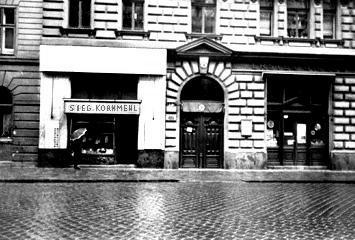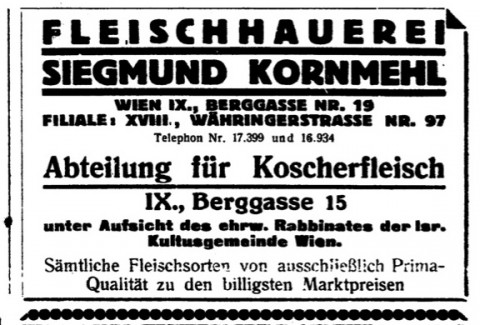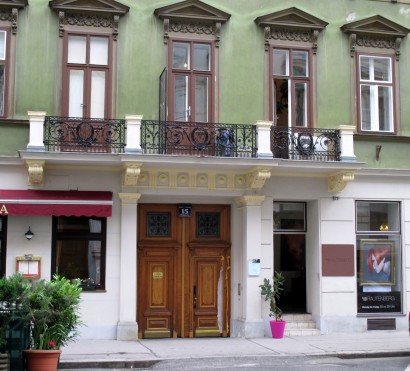
I was in Vienna’s Jewish Records Office last week — was it really only last week? — looking to fill in some key bits of my family history. When archivist Irma Wulz showed me the marriage records of my grandparents, Hermann Rosenbaum and Ernestine Kornmehl, I wasn’t especially surprised to learn that the wedding witnesses had been David Schmerling, Ernestine’s brother-in-law and also her first cousin, as well as Siegmund Kornmehl, one of my grandmother’s three brothers. I knew that all these family members had been close.

Ms. Wulz translated for me the professions that my grandfather and the witnesses had listed: Hermann Rosenbaum was an office clerk–a pretty vague designation; I wondered if he had a private life anything like Franz Kafka’s–while David Schmerling was a jeweler and Siegmund Kornmehl a butcher. A look of delight suddenly came across the archivist’s face when she noticed the address that Siegmund had listed for himself: 19 Berggasse. She turned to me, ready to provide a revelation.
I smiled and nodded. I already knew the significance of that address, and that Siegmund Kornmehl had been Sigmund Freud’s fleischhauer.
Browsing Bergasse

In fact, I had spent the previous few days exploring old family haunts. Siegmund Kornmehl owned two additional properties on the block, another butcher shop and an apartment building. My hotel, the wonderful Best Western Harmonie, was only a short walk from Berggasse, and I passed the street nearly every day on my way to the underground.
Berggasse, I should mention, means Mountain Street, and when I first encountered it, I groaned inwardly: I was sure I would be hiking up a rather steep incline from the main drag, Lichtensteinstrasse, whenever I wanted to visit. I was pleasantly surprised to find the addresses I was seeking were on a gentle downward slope.
Coincidentally, the closest cross street to my address in Tucson is named Mountain Avenue. I thought I’d throw that in since I already went down the woo-woo road with my post about a deer spirit guide in the Zentralfriedhof cemetery.
Now—and Then
I took the above picture of 19 Berggasse on a quiet morning, before the Sigmund Freud Museum opened. The photo below, taken by Edmund Engelman, who documented Freud’s home and office two weeks before the family left Vienna for London in June 1938, shows the building when Siegmund Kornmehl still had his business here; he was forced by the Nazis to sign over any claim to ownership a few months later, in October. As you can see, the building is pretty much unchanged, except for the absence of the butcher shop sign and–difficult to see here, happily–the swastika over the main entryway, and the addition of benches and bicycle racks.
From Butcher Shop to Art Gallery
The impetus for starting this blog, nearly two years ago, was the discovery that Siegmund Kornmehl’s butcher shop was in Freud’s building and that it had been transformed into an art gallery for the Freud Museum. Others, I thought, were traipsing through a bit of family history that I knew nothing about.
Here’s a closeup of that gallery from the quiet morning picture above:
It turns out I was wrong about the traipsing part; the gallery isn’t one in most conventional senses of the term, merely a window display that can’t be browsed from inside. I guess that’s what “A View from the Outside,” the Joseph Kosuth work that introduced the conversion of the butcher shop in 2001, meant. I have to admit that went right over my head.
I was also disappointed by the gallery’s size. The space is tiny, representing only a small portion of the original shop, which is mostly used as storage space for the museum; I snuck a peek in later, and found the onetime thriving business piled with boxes and files. As for the art, when I visited, a small abstract sculpture was on display. I’m afraid I couldn’t fathom its connection to Freud, neither to his theories nor to his life.
All in all, I was feeling pretty obtuse.
I realize it’s virtually impossible to see the sculpture, or much of anything else, from the picture below, another not-so-successful attempt to capture the space without reflection. If you look carefully, however, you can see me shooting the picture, and also see the building across the street.
More Kornmehl Property—And Claims to Fame
It’s a significant building, as it turns out: #18 Berggasse also belonged to Siegmund Kornmehl.* I don’t know that he ever lived there; I have only seen documents proving that he was forced to sign over ownership to the building at the same time as he signed over the butcher shops–more on that in a minute. Siegmund and his wife, Helen, didn’t have any children. After they war, they adopted their niece, Stella Schmerling (daughter of David, whom I mentioned earlier as one of the two witnesses to my grandparents’ wedding), in order to get the properties back for her and her family. They were not very successful.
I also know that Minna Kornmehl Allina, the sister of one of Siegmund Kornmehl’s brothers-in-law, lived there with her four children; she rented space to boarders from the nearby University of Vienna to help make ends meet.

Notice the graffiti on the door’s bottom. The neighborhood–part of Alsegrund, the 9th district–is fairly gentrified but not entirely so.
Now here’s where it gets more interesting, historically speaking. One of Minna’s four children, Curt Allina, may not have been as famous as Freud, but he nevertheless had some influence on popular culture. After he fled to the U.S., Allina rose up the ranks of Pez, an Austrian company, and he is credited with creating the iconic candy dispensers. There is a picture of the earlier Pez-without-heads next to the title of this post. The words mean “the sweet joy” (yes, “Freude” means joy).
I don’t know if you’ve ever tasted the candy, but I have and can assure you the company would literally be history without those dispensers to keep the business going.
You can read more about Curt Allina and his career here.
Decades after he left Vienna, Curt claimed in his Shoah testimony that he used to peer into Freud’s office from his home across the street when he was a boy. I discovered that this would have been impossible from any angle of Berggasse #18. Freud’s couch could only be seen from the courtyard of #19, and even from there it would have been obscured by trees. That’s okay. Memory plays tricks, as Freud would be the first to confirm.
Curt also said that he mostly remembers Freud as an old man in the neighborhood, which does seem likely.
Another Butcher Shop
Speaking of inaccuracies, although all the Freud Museum literature calls Siegmund Kornmehl’s butcher shop at 19 Berggasse “kosher,” that’s not the case, as this ad from the January 22, 1926, edition of Die Wahrheit, Vienna’s key Jewish newspaper, indicates:
I blogged about this in some detail here but, in brief, #19 was the primary butcher shop, with two satellites. The kosher one, noted to be under rabbinical supervision, is down the block, at #15. The third shop–like the main one, not kosher–was on 97 Wahringerstrasse, in district 18. I saw the building on the bus en route to Freud’s summer home, which is whole other story.
So, the final Kornmehl- and Freud-related building on the block is #15 Berggasse, below:
How is Freud related? Freud’s wife, the former Martha Bernays, was the granddaughter of Hamburg’s chief rabbi; she had wanted to run an observant Jewish household, as her parents’ had been, but her husband objected. It wasn’t until after Freud’s death that she started lighting shabbos candles again. It seems reasonable to assume that, unbeknownst to her husband, she ducked into Berggasse 15, two stores down from her home, and bought kosher meat from Siegmund Kornmehl. When she wasn’t serving Freud ham, of course. But that’s another, longer story.
I’m not sure where the kosher butcher shop might have been, but it’s a lovely building, isn’t it?
*UPDATE: There’s a chance #18 might have belonged to the Other Siegmund Kornmehl, the cafetier–which would make sense since it was his sister who was living there. The records I saw don’t specify the property owner’s profession.








Lovely post documenting all the Kornmehl abodes and establishments on Berggasse. What is very clear is that the Freud family was — subconsciously of course — being observed by Kornmehl family members wherever they roamed on that street. He was surrounded by them and the Freud Museum would be a wonderful place to highlight their interactions and co-existence in an exhibit in the former Kornmehl butcher space. Much more interesting than the art gallery!
Thanks, Jill. I admit I loved the idea of the young boy, Curt Allina, thinking of Freud as just an old guy he saw around the neighborhood, even though he was very famous by then. Kids tend to cut through all pretense and, later in life, Curt must have been tired of being asked about Freud. I agree, of course, about the art gallery. 🙂
I share with you the feelings of getting to know the places our families lived and worked. My deep experience was in Poland. It is putting pieces of a huge puzzle together!
It is like a puzzle, isn’t it? And it is even more interesting when you are there in person, and can see it for yourself. I’m glad you had a similar experience in Poland!
The connection between Freud and Pez is too wonderful, Edie! (God, how I lusted after those as a kid.) The invention of psychoanalysis and that of a genius candy product, all in one little stretch of sidewalk. That’s what I call history.
BTW, it may not be that relevant, but your post made me think of a book I love. It’s by Stewart Brand (the Whole Earth Catalog guy) – “How Buildings Learn.” It offer a lot of fascinating insights into how and why buildings morph over time as people put them to various uses. Maybe you’d find it interesting – I have a copy.
It’s funny, I only remember the candies only vaguely when I was a kid, even though they were Austrian (or maybe that’s why my parents avoided them)! That branch of the family was fairly close to ours in Brooklyn, but I don’t think my mother knew about her cousin Curt’s claim to fame, which happened somewhat later. Of course, sweets were not encouraged of any sort.
That book sounds very interesting, especially since, on the site of Freud’s building was another building that was demolished, one where Viktor Adler — the head of the Austrian Labor Party and another relative! — once lived. I forgot to mention that in this piece… I’ll look forward to seeing you and borrowing it.
Thrilling to read how much more you again found out of, so much history on one place.
Yes, it really was exciting — much of this I knew in bits and pieces but it was great to have it all come together.